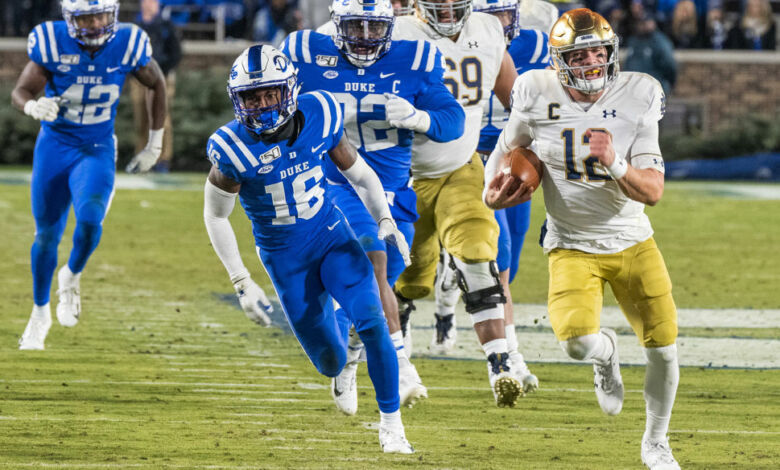
There was a lot of discussion last week about the job offensive coordinator Chip Long was doing as a play-caller. I wrote a whole thing about it, although the conclusion was it was more likely execution errors than it was poor calls from Long. I also noted it’s challenging to identify a poor call just based on the result of the play; there are so many different variables, without knowing most of them it is hard to say.
This week though, offered a few examples of strong play-calling and at the very least strong play design, and as to not just pick out obvious plays, I chose one that ended in an interception. See, even good calls sometimes go wrong.
The game Saturday against Duke was a huge step in the right direction both for Long and his quarterback, some may say too little too late, but if we aren’t willing to identify progress being made then what are we doing here in the first place? If you’re going to call a spade a spade, then it has to happen for both the bad and the good.
Creating Mismatches
When watching these games, the thought would frequently pop into my head that we don’t seem to create mismatches for our best players. We’re often just out there doing our stuff, and we are relying on execution rather than scheme to find our good plays. There is nothing wrong with that, of course; the mark of a good program involves executing better than your opponent more often than not. That has to be the case for Brian Kelly and his offense because they aren’t littered with highly ranked players, especially at the skill positions. They can’t simply out talent most teams.
It’s great to focus on the execution aspect, but when the offense struggles, it’s nice also to be able to scheme quality play as well. We saw something like this late in the second quarter against Duke.
Notre Dame goes trips to the field side, with Chase Claypool, the third player in from the sideline, and tight end Cole Kmet playing attached to the line on the opposite side. Duke is playing a cover two defense, and Long wants to get Claypool isolated in the deep middle against a linebacker. He does this by occupying the boundary safety with a deep out from Cole Kmet, and holding the field safety with a seam route from Chris Finke. This leaves the middle of the field wide open, with Claypool running right down the middle of the formation, and the middle linebacker chasing him.
The play is there, but guard Trevor Ruhland gets beaten inside by a defensive lineman, which causes Ian Book to shuffle to his left and attempt a pass while moving. The defense gets there right as the ball is thrown, his arm is hit, and it’s an interception.
Really like this play design against Cover 2 from Long. They occupy the play side safety with a deep out from Kmet, hold the backside safety with a seem from Finke, and get Claypool matched up against a linebacker deep down the middle. pic.twitter.com/134eYVd4zI
— Greg Flammang (@greg2126) November 11, 2019
I think Book, for his part, makes a mistake here in not throwing to Kmet. It’s understandable that he wanted to take advantage of Claypool and that mismatch, and had he thrown it; the play is there. But, he does have Kmet open early, and the problem with passing on that throw is once he opts out of it, he can’t go back to it, and the window is closed. Also, this play came on second and 10, a down where it’s more advisable to take the higher percentage throw and move the chains, rather than a much lower percentage deep shot, which has 3rd and 10 coming written all over it.
Understandable given the mismatch, but with the game situation, the out route is right there for him — still, very solid play call and design.
Giving Multiple Options For Success
On the second Chris Finke touchdown in the third quarter, Chip Long called a play that had the original design been taken away; there was a good fall back option available for Book to go to.
First, let’s check out the action to the outside. They are setting up a pretty standard goal-line play where they try to create traffic on the outside and hit the receiver in the flat for a touchdown. This is essentially the play they ran to beat Florida State in 2014 (yes, I do mean to say that they beat them.) although with a bit of a wrinkle. First, Finke goes into motion, which allows Book to identify man or zone defense. Javon McKinley does the standard, “head up field and turn around” route we see from the on the LOS player in the trips formation. A wrinkle is instead of Claypool running an inside route, like a slant, he heads outside, as if to be running fade. This occupies the corner directly opposite of him. Man or zone, he has to respect the fade route being run right at him, and he then opens up the flat for Finke to occupy.
If this gets stymied, though, Book has a shovel pass action to Tony Jones Jr. being run at the same time, with the line pulling into position to clear the way for the back. It certainly appears if Book chose to flip to Jones Jr., he walks into the end zone. Nifty play design near the goal line.
Interesting wrinkle to this touchdown play to Finke. If the secondary brackets the receivers, Book has a shovel pass to Jones Jr. available. If he went this route it looks like he would have walked in. pic.twitter.com/oVVtr3CfEO
— Greg Flammang (@greg2126) November 11, 2019
Adjustments To The Running Game
Last week was also Ian Book’s best game as a runner, and it was not by accident. Brian Kelly said Long deliberately got Book involved in this area, seeing a weakness in the defense and a way to utilize his quarterback in a way that they had yet to put on film. Little tweaks like this are the types of things we’ve wanted to see out of the offense during the first seven weeks, and while it would have been nice to have seen them in the bigger games, it’s a good sign that Long is showing he can make the adjustments he needs to get the offense going.
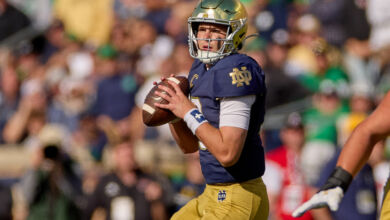
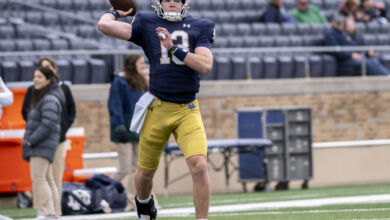
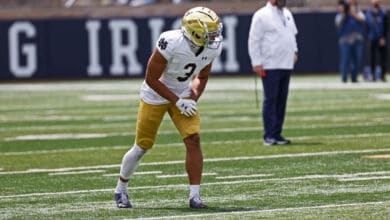
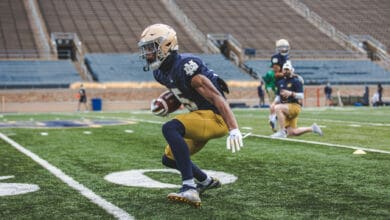
The press coverage we see is usually in concert with edge blitzes and d-ends pushing for 2 steps then getting their hands up to cut off the slant routes. They do this because they have all watched Kelly refuse to adjust and simply sit a TE down about 10 yards over the line of scrimmage in the middle of the field behind the LB’s. Kmet cost the 1st such ball I’ve seen sense Kelly arrived 10 years ago against Duke. Kelly will only use the middle of the field for crossing and seam routes which every team has exploited in the major beat downs we have taken against USC, UM, Clemson, Alabama, and Miami. UGA also used the same technique. Kelly wond his DII national titles with game manager QB’s at GVS and he refuses to evolve into a coach that lets absolute talent such as PJ use it to bring ND back to national prominence. He feels more comfortable with game managers such as Rees and Book and refuses to adjust his offense to match their talent set of his QB’s. Look at Bama, as soon as Tua proved more talented than Hurt, Hurt was out. Clemson did the same with Kelly Bryant as soon as Lawrence proved better. Both of the replaced QB’s won Nati’s. Kelly will not win a title at ND until he starts to really look at his shortcomings, adjust to how other teams see him and is willing to maximize the skillsets of his players. This is not DII.
Nice article and it has its points. If this was a 1st or even 2nd game of the season, I might feel pretty positive. However, it’s the 9th game into the season and patting backs and “high giving” over Duke doesn’t exactly bring out the thunder when in the 2 more meaningful games, play calling and/or execution , were at issue. I would rather see an article like this if it’s about a top caliber opponent getting beat by ND. To me, that’s a little more meaningful as a fan.
Go Irish
Sink Navy
No freakin doubt Storespook
We are lucky to have Chip. The cupboards were left bare after Dexter Williams Josh Adams departure at RB. Really thin at wr outside of Chase Claypool. Next year will be worse with Chase, Kmet and Finke gone. They will need freshman help at RB, TE, and WR. We need talent.
Cmac,
I’ve never seen you post on here but you just lost all credibility with me on saying we are lucky to have Chip..
I was at all home games of Parseghian’s first season at N.D. The immediate impression one got seeing these guys play was the Precision of Execution. It was pbvious they had prepared thproughly fpr each game.
Great article. Nice analysis. This was a good follow-up to your Nov. 8 article. Keep up the good work.
At some point, I’d like to hear a receiver (maybe Tim Brown?) comment on the routes and route trees.
Our receivers do not seem especially fast to me. Therefore, teams seem willing to run press-man against us.
And, it seems that we have a lot of safeties playing close to the line of scrimmage.
If the receivers run crisp routes, with sharp breaks at consistent points, that would seem to create an opportunity for Book to throw with timing.
OTOH, if the receivers run inconsistent routes and round off their breaks, it forces the QB to hold the ball and wait.
I wonder if that is happening to our offense at times?
I have one thing to say about the great play calling: We played Duke.
Congratulations to Chip Long for calling his best game of the year 2/3rds into the season against Duke!!!!
agree the offensive performances have for the most looked pretty bad.I think these next 4 games are going to tell us a lot about what changes we will see this off season.if the offense doesn’t show much I think Kelly will make some changes. Qb competition new qb coach new o coordinator different schemes structure who knows.
This narrative sounds like Chip is a first year OC and is making slow progress. Time for a change.